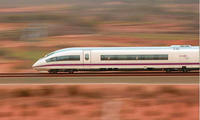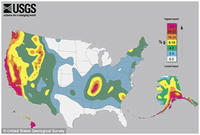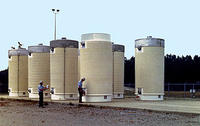-
Competitors selected for DARPA Spectrum Challenge
As wireless devices proliferate and the radio spectrum becomes ever more congested, all users have a common interest in radio technologies that can accommodate the largest number of users but still enable priority traffic to get through. Three wild card selections remain to be selected for the DARPA Spectrum Challenge, a competition aiming to demonstrate solutions for more robust wireless radio technologies.
-
-
Social media analytics help emergency responders
If you think keeping up with what is happening via Twitter, Facebook, and other social media is like drinking from a fire hose, multiply that by seven billion — and you will have a sense of what researchers who are working on SALSA (SociAL Sensor Analytics) are facing. Efforts of emergency responders and public health advocates could be boosted by SALSA.
-
-
Mississippi towns build tornado-proof domes

Following a devastating tornado two years ago, the town of Smithville, Mississippi, has started construction on a tornado-proof dome. The dome, to be built on the grounds of the local high school, will double as a gym and a storm shelter. Other towns in Mississippi have also begun their own dome projects.
-
-
Automakers help Detroit emergency services
General Motors, Ford Motors, and the Chrysler Group joined Blue Cross Blue Shield of Michigan, Quicken Loans, and several other businesses in the Detroit area to donate $8 million for new ambulances and police cars, on the same day that emergency manager Kevyn Orr started his job.
-
-
Cockroaches gait informs search-and-rescue robot design
More than 70 percent of Earth’s land surface is not navigable by wheeled or tracked vehicles, so legged robots could potentially bridge the gap for ground-based operations like search and rescue and defense. New insights on how cockroaches stabilize could help engineers design steadier robots for operating on difficult terrain.
-
-
Jumping soft robots avoid obstacles during search and rescue operations
These soft robots can already stand, walk, wriggle under obstacles, and change colors. Now researchers are adding a new skill to the soft robot tool kit: jumping. Researchers make the robots jump by using combustible gases. This ability to jump could one day prove critical in allowing the robots to avoid obstacles during search and rescue operations.
-
-
How to act if there is a fire on a high-speed train

Researchers have used computer models to analyze the best way to evacuate the Spanish High Speed Train (AVE) in the case of fire; the involvement of the crew in organizing the fast transfer of passengers, completing the process before the train comes to a halt, and collective collaboration to assist those with reduced mobility are just some of the strategies to be followed
-
-
Earthquake risk looms large in the Pacific Northwest

A comprehensive analysis of the Cascadia Subduction Zone off the Pacific Northwest coast confirms that the region has had numerous earthquakes over the past 10,000 years, and suggests that the southern Oregon coast may be most vulnerable based on recurrence frequency
-
-
Men in maritime disasters save themselves first --“women and children first” is a myth

Since the sinking of the Titanic, there has been a widespread belief that the social norm of “women and children first” gives women a survival advantage over men in maritime disasters, and that captains and crew members give priority to passengers; a new study find that the Titanic disaster, in which 70 percent of the women and children on board were saved compared to 20 percent of the men, is a glaring exception to the rule; during maritime disasters, men use their relative strength to save themselves; what is more, studies of human behavior during natural disasters show the same results: in life-and-death situations, it is every man for himself
-
-
Science group: storing spent nuclear fuel in dry casks significantly safer then wet pools storage

An NRC report on the lessons of the Fukushima disaster says that storing spent nuclear fuel in wet pools is “adequate” to protect the public; a science groups says there is a significantly safer way to store the 55,000 tons of radioactive waste currently stored by the 104 nuclear power plants operating in the United States: transferring the spent fuel to dry casks
-
-
Using cold plasma to fight fires
Traditional fire-suppression technologies focus largely on disrupting the chemical reactions involved in combustion; from a physics perspective, however, flames are cold plasmas; DARPA, the Pentagon’s research arm, theorized that by using physics techniques rather than combustion chemistry, it might be possible to manipulate and extinguish flames
-
-
Small, local energy technologies to help sustain vital services during blackouts
Researchers suggest that rethinking the solution to sustaining electric power — namely, starting small — could keep critical services going, even when the high-voltage grid is crippled; the U.S. military is already taking steps to protect its power supplies in the event of a massive grid failure by adopting small, local energy technologies, and California governor Jerry Brown recently announced that he wants 12,000 megawatts of such power supplies in his state
-
-
TeleCommunication Systems acquires next-generation 9-1-1 technology specialist microDATA GIS
The Federal Communications Commission (FCC) predicts that state and local governments will spend up to $1.2 billion over the next ten years for NG9-1-1 upgrades, with an additional $1.5 billion spent on recurring connectivity, hosting, and operations and maintenance; TeleCommunication Systems acquires microDATA GIS, a next-generation 9-1-1 technology specialist
-
-
Bomb threat? There’s an app for that

In the first chaotic moments after suspicion of a bomb threat, first responders have a myriad of questions, assessments, and decisions to make, all at once, and all the while the scene could be changing rapidly: Is the bomb real? How large is the potential blast radius? Where will we evacuate people? Are there any critical infrastructure or special-needs population centers in the vicinity? Any schools, hospitals nearby? What roads should be closed? Which roads should stay open for evacuees? There are many more questions, many more uncertainties; DHS Science and Technology Directorate (S&T) and its private sector partners have now developed a must-have app: the First Responder Support Tools (FiRST) for computers and smartphones
-
-
EF Johnson named to DHS TacCom supplier group
TacCom is a multiple award Indefinite-Delivery, Indefinite-Quantity (IDIQ) contract established in 2012 to help DHS purchase a full array of tactical communications products, infrastructure, and services for mission critical, public safety communications; the total funds spent on equipment through this contract may not exceed $3 billion, inclusive of options
-
- All
- Regional
- Water
- Biometrics
- Borders/Immig
- Business
- Cybersecurity
- Detection
- Disasters
- Government
- Infrastructure
- International
- Public health
- Public Safety
- Communication interoperabillity
- Emergency services
- Emergency medical services
- Fire
- First response
- IEDs
- Law Enforcement
- Law Enforcement Technology
- Military technology
- Nonlethal weapons
- Nuclear weapons
- Personal protection equipment
- Police
- Notification /alert systems
- Situational awareness
- Weapons systems
- Sci-Tech
- Sector Reports
- Surveillance
- Transportation
Advertising & Marketing: advertise@newswirepubs.com
Editorial: editor@newswirepubs.com
General: info@newswirepubs.com
2010-2011 © News Wire Publications, LLC News Wire Publications, LLC
220 Old Country Road | Suite 200 | Mineola | New York | 11501
Permissions and Policies
Editorial: editor@newswirepubs.com
General: info@newswirepubs.com
2010-2011 © News Wire Publications, LLC News Wire Publications, LLC
220 Old Country Road | Suite 200 | Mineola | New York | 11501
Permissions and Policies
